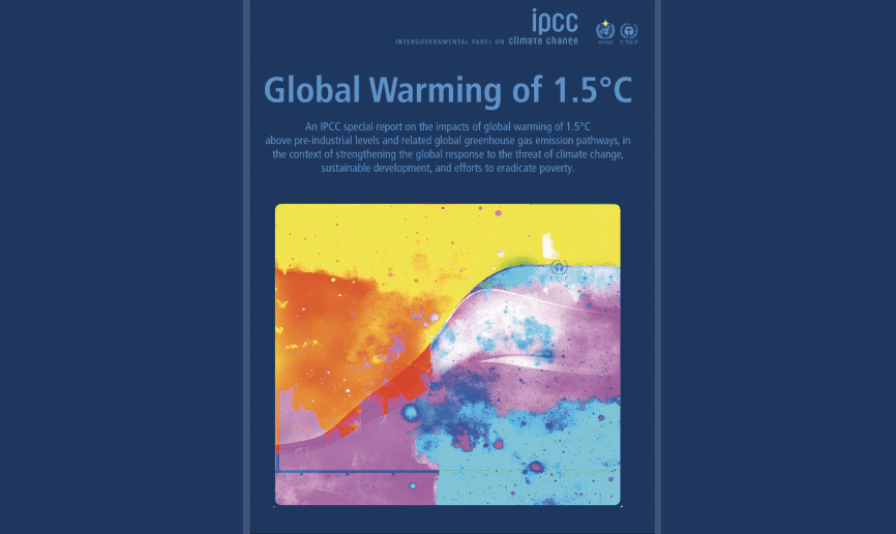What Has Been The Main Cause Of Development-related Climate Change?
2019 was the second warmest year on record and the end of the warmest decade (2010- 2019) ever recorded.
Carbon dioxide (CO2) levels and other greenhouse gases in the atmosphere rose to new records in 2019.
Climate change is affecting every country on every continent. It is disrupting national economies and affecting lives. Atmospheric condition patterns are changing, sea levels are rise, and weather events are becoming more than extreme.
Although greenhouse gas emissions are projected to drop about 6 per cent in 2020 due to travel bans and economic slowdowns resulting from the COVID-19 pandemic, this comeback is merely temporary. Climate change is not on pause . In one case the global economy begins to recover from the pandemic, emissions are expected to return to college levels.
Saving lives and livelihoods requires urgent action to address both the pandemic and the climate emergency.
The Paris Agreement , adopted in 2015, aims to strengthen the global response to the threat of climate alter past keeping a global temperature rise this century well beneath 2 degrees Celsius to a higher place pre-industrial levels. The agreement also aims to strengthen the ability of countries to bargain with the impacts of climate change, through advisable fiscal flows, a new technology framework and an enhanced capacity building framework.
COVID-19 response
 As countries move toward rebuilding their economies after COVID-nineteen, recovery plans can shape the 21st century economy in means that are clean, green, healthy, safe and more than resilient. The current crisis is an opportunity for a profound, systemic shift to a more sustainable economy that works for both people and the planet.
As countries move toward rebuilding their economies after COVID-nineteen, recovery plans can shape the 21st century economy in means that are clean, green, healthy, safe and more than resilient. The current crisis is an opportunity for a profound, systemic shift to a more sustainable economy that works for both people and the planet.
The UN Secretary-General has proposed six climate-positive actions for governments to take one time they get virtually building dorsum their economies and societies:
- Green transition: Investments must advance the decarbonization of all aspects of our economy.
- Greenish jobs and sustainable and inclusive growth
- Light-green economic system: m aking societies and people more resilient through a transition that is off-white to all and leaves no one behind.
- Invest in sustainable solutions: fossil fuel subsidies must end and polluters must pay for their pollution.
- Confront all climate risks
- Cooperation – no country tin can succeed solitary.
To address the climate emergency, post-pandemic recovery plans need to trigger long-term systemic shifts that will change the trajectory of CO2 levels in the atmosphere.
Governments around the earth take spent considerable time and effort in recent years to develop plans to nautical chart a safer and more than sustainable hereafter for their citizens. Taking these on board now equally part of recovery planning tin can help th east world build back improve from the current crisis.
Climate Activity Summit 2019
With global emissions are reaching record levels and showing no sign of peaking, UN Secretary-General António Guterres called on all leaders to come to New York on 23 September 2019 for the Climate Action Superlative with concrete, realistic plans to enhance their nationally determined contributions by 2020, in line with reducing greenhouse gas emissions by 45 per cent over the next decade, and to net zero emissions by 2050.
Read the Study of the Secretary-Full general on the outcomes of the Summit.

Limiting global warming to one.5ºC would require rapid, far-reaching and unprecedented changes in all aspects of society, the Intergovernmental Panel on Climate Change (IPCC) said in their Climate Report 2018. With clear benefits to people and natural ecosystems, limiting global warming to 1.5ºC compared to 2ºC could go hand in hand with ensuring a more sustainable and equitable order.
For more UN climate reports, click here.

- As of Apr 2018, 175 parties had ratified the Paris Agreement and 168 parties had communicated their commencement nationally determined contributions to the Un framework convention on Climate Change Secretariat.
- As of Apr 2018, 10 developing countries had successfully completed and submitted their first iteration of their national accommodation plans for responding to climatic change.
- Developed country parties go along to make progress towards the goal of jointly mobilizing $100 billion annually by 2020 for mitigation actions.
Thank you to the Intergovernmental Console on Climate change we know:
- From 1880 to 2012, average global temperature increased by 0.85°C. To put this into perspective, for each 1 degree of temperature increment, grain yields refuse by almost 5 per cent. Maize, wheat and other major crops take experienced pregnant yield reductions at the global level of 40 megatons per year between 1981 and 2002 due to a warmer climate.
- Oceans have warmed, the amounts of snowfall and ice have macerated and sea level has risen.From 1901 to 2010, the global average sea level rose by 19 cm as oceans expanded due to warming and ice melted. The Arctic'due south sea water ice extent has shrunk in every successive decade since 1979, with 1.07 meg km² of water ice loss every decade
- Given current concentrations and on-going emissions of greenhouse gases, it is likely that by the terminate of this century, the increment in global temperature will exceed one.v°C compared to 1850 to 1900 for all but one scenario. The globe's oceans will warm and ice melt will continue. Average sea level rise is predicted every bit 24 – 30cm by 2065 and 40-63cm by 2100. Most aspects of climate change will persist for many centuries even if emissions are stopped
- Global emissions of carbon dioxide (CO2) have increased by most 50 per cent since 1990
- Emissions grew more than quickly betwixt 2000 and 2010 than in each of the three previous decades
- It is still possible, using a broad array of technological measures and changes in behavior, to limit the increment in global mean temperature to two degrees Celsius above pre-industrial levels
- Major institutional and technological alter will give a amend than even chance that global warming will not exceed this threshold
thirteen.1Strengthen resilience and adaptive chapters to climate-related hazards and natural disasters in all countries
13.2Integrate climate change measures into national policies, strategies and planning
13.3Improve instruction, sensation-raising and human and institutional capacity on climate change mitigation, adaptation, impact reduction and early on warning
xiii.AImplement the commitment undertaken past developed-state parties to the United nations Framework Convention on Climatic change to a goal of mobilizing jointly $100 billion annually by 2020 from all sources to address the needs of developing countries in the context of meaningful mitigation actions and transparency on implementation and fully operationalize the Green Climate Fund through its capitalization equally soon as possible
13.BPromote mechanisms for raising capacity for effective climatic change-related planning and direction in least developed countries and pocket-size island developing States, including focusing on women, youth and local and marginalized communities
*Acknowledging that the Un Framework Convention on Climate Change is the main international, intergovernmental forum for negotiating the global response to climate change.
The Paris Agreement on climate change
The UN continues to encourage all stakeholders to take action toward reducing the impacts of climate change.
COP25: Madrid, 2019
 The Madrid Climate change Conference – COP25 – brought the world together to consider ways to strengthen the implementation of the Paris Understanding. Taking place from ii to sixteen December in Madrid, the Conference came at a time when new data shows the climate emergency is getting worse every twenty-four hours, and is impacting people'southward lives everywhere, whether from extreme heat, air pollution, wildfires, intensified flooding or droughts. Read our blogs from the Briefing here.
The Madrid Climate change Conference – COP25 – brought the world together to consider ways to strengthen the implementation of the Paris Understanding. Taking place from ii to sixteen December in Madrid, the Conference came at a time when new data shows the climate emergency is getting worse every twenty-four hours, and is impacting people'southward lives everywhere, whether from extreme heat, air pollution, wildfires, intensified flooding or droughts. Read our blogs from the Briefing here.
COP24: Katowice, 2018

At the end of COP24, countries stressed "the urgency of enhanced ambition in club to ensure the highest possible mitigation and adaptation efforts by all Parties," and agreed on a set up of guidelines for implementing the landmark 2015 Paris Climate Change Agreement.
COP23: Bonn, 2017

The 2017 Un Climate Conference took place in Bonn, Germany, from half dozen-18 November. Leaders of national governments, cities, states, business, investors, NGOs and ceremonious social club gathered to speed up climate action to run into the goals of the Paris Climate change Agreement.
COP22: Marrakesh, 2016
 The 22nd session of the Conference of the Parties (COP 22) to the UNFCCC took place in Marrakesh, Morocco. During COP 22, parties began preparations for the entry into strength of the Paris Agreement, and to encourage deportment to implement the agreement that will address climatic change.
The 22nd session of the Conference of the Parties (COP 22) to the UNFCCC took place in Marrakesh, Morocco. During COP 22, parties began preparations for the entry into strength of the Paris Agreement, and to encourage deportment to implement the agreement that will address climatic change.
Loftier-Level Event Towards Entry into Force: 21 September, 2016
 United nations Secretary-General Ban Ki-moon convened a special "High-Level Event on Entry into Strength of the Paris Agreement on Climate Alter" on 21 September at the UN Headquarters in New York, to provide an opportunity to other countries to publicly commit to joining the Paris Agreement before the cease of 2016.
United nations Secretary-General Ban Ki-moon convened a special "High-Level Event on Entry into Strength of the Paris Agreement on Climate Alter" on 21 September at the UN Headquarters in New York, to provide an opportunity to other countries to publicly commit to joining the Paris Agreement before the cease of 2016.
Recap of the High-Level Consequence Towards Entry into Strength
Paris Agreement Signing Ceremony, 22 April 2016

To keep the global spotlight focused on climate change and build on the potent political momentum from Paris, United nations Secretary-General Ban Ki-moon invited representatives of all countries to signthe Paris Agreement on climate changeat a special Ceremony at the Un Headquarters on 22 April.
COP21, 12 December 2015

The Paris Agreement was adopted by all 196 Parties to the United nations Framework Convention on Climate change at COP21 in Paris on 12 Dec 2015. In the agreement, all countries agreed to work to limit global temperature rise to well beneath 2 degrees Celsius, and given the grave risks, to strive for 1.5 degrees Celsius. Implementation of the Paris Agreement is essential for the achievement of the Sustainable Development Goals, and provides a roadmap for climate actions that will reduce emissions and build climate resilience.
Paris Agreement – Oft Asked Questions
The Paris Understanding on climatic change officially entered into forcefulness on 4 November 2016, after 55 countries accounting for 55 per cent of the total global greenhouse gas emissions, deposited their instruments of ratification, credence or approving with the Un Secretary-General.
Every bit of 28 September 2017, 166 countries have joined the Paris Agreement.
The agreement provides a pathway forward to limit temperature rising to well below ii degrees, maybe even one.5. The understanding provides a machinery to increase the level of ambition.
The Paris Agreement is an ambitious, dynamic and universal agreement. It covers all countries and all emissions, and is designed to final. This is a monumental agreement. It solidifies international cooperation for climatic change. It provides a way forward.
The Paris Understanding sends a powerful bespeak to markets that now is the fourth dimension to invest in the low emission economy. It contains a transparency framework to build mutual trust and confidence.
Information technology will serve as an of import tool in mobilizing finance technological support and capacity building for developing countries. And it will as well help to scale up global efforts to accost and minimize loss and damage from climate change.
Paris is a beginning—we at present take to implement the Agreement. Only nosotros have taken a giant step forward.
The understanding is ambitious and information technology provides all the tools we need to accost climate change, for reducing emissions and to accommodate to the impacts of climatic change.
The proof will be in the implementation, by governments, businesses and civil society.
Countries officially submitted their own nationally determined climate actions. They have an obligation to implement these plans, and if they practise, it volition bend the bend downward in the projected global temperature rise.
The understanding not only formalizes the process of developing national plans, but also it provides a binding requirement to assess and review progress on these plans. This mechanism will crave countries to continuously upgrade their commitments and ensure that at that place will be no backtracking.
This understanding is a blaring phone call from governments that they are ready for implementing the 2030 Sustainable Development Agenda.
At that place is no benefit to flouting the Agreement. Any brusk-term fourth dimension gain will be brusque-lived. Information technology will undoubtedly exist overshadowed by negative reactions, past other countries, financial markets, and most important, by their citizens.
We have an agreement and nosotros have a chance now to reach our goal. We couldn't say that without an understanding. The Paris Agreement will put united states on a pathway to achieve the 2 degree goal or less. Nosotros did not expect to get out Paris with commitments to attain that goal, but rather, with a procedure that will go us there. And that is what the Agreement provides.
The Paris Conference featured thousands of climate action announcements that demonstrated how civil order and the private sector are moving forrad to address climate change.
We can limit global temperature rise to less than 2 degrees if we take action now. We demand all countries and all sectors of society to act now—it is in the interests of anybody.
It is achievable. Taking climate action now makes skillful economic sense. The more we delay, the more nosotros pay. We tin promote economic growth, eradicate extreme poverty, and improve people's health and well-being by acting today.
Related News
Related Videos
Source: https://www.un.org/sustainabledevelopment/climate-change/
Posted by: nestorswilifewouse.blogspot.com


0 Response to "What Has Been The Main Cause Of Development-related Climate Change?"
Post a Comment